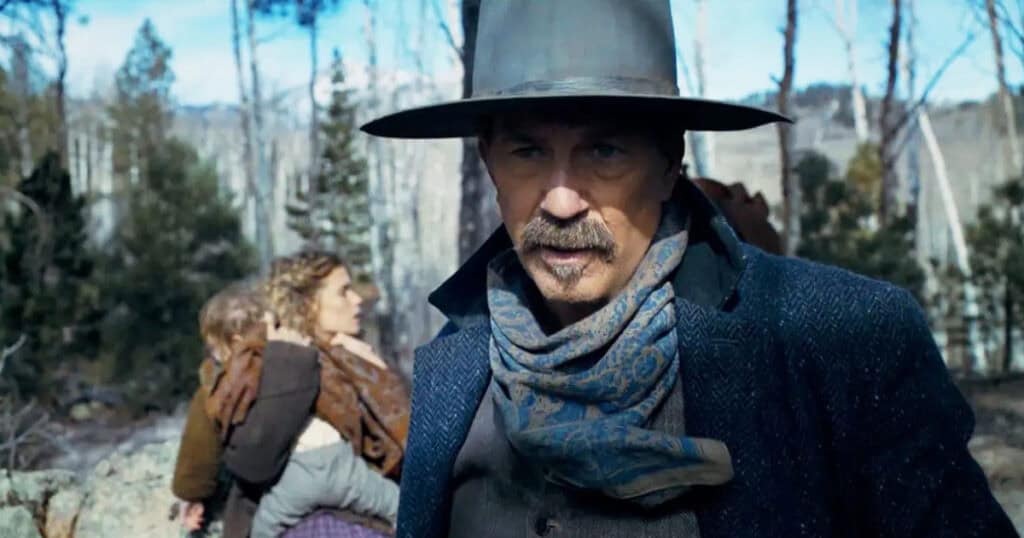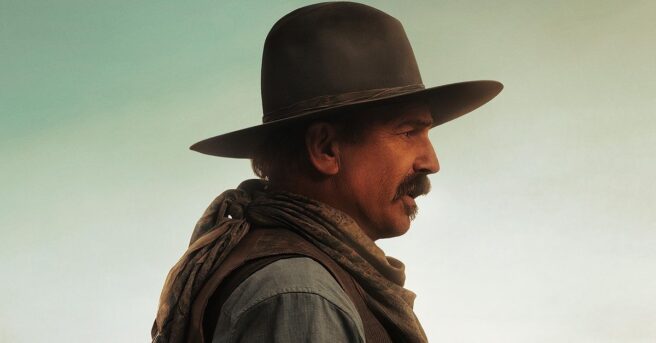
PLOT: An epic saga of the various groups who try to settle the ever-expanding horizon of the old West.
REVIEW: Kevin Costner’s Horizon might be the most ambitious movie undertaking since Lord of the Rings. Think about it – Kevin Costner has sunk a huge chunk of his own personal fortune into making an epic Western saga, with a second movie only weeks away from hitting theatres, regardless of whether or not the first makes him any money. If that weren’t enough, he’s already started shooting pieces of the third film, and he’s sworn he’ll be making a fourth film as well. Given the scope of his ambitions, it’s hard to truly judge Horizon – Chapter 1 as a standalone film, with it so clearly part of a much bigger whole.
Running three hours (with credits), Costner, who also directed, produced and co-wrote the film (with Jon Baird), has to do a lot of set-up here, with much of the movie devoted to establishing the many characters the saga is built around. Costner himself, who is front and center in the advertising, is only such one character, with him only entering the film about an hour in and having no more screen time than any of the other major roles. Even if it is largely a movie setting up further, presumably more action-packed instalments in the Horizon saga, it’s nevertheless the kind of compelling, old-fashioned epic they don’t make anymore.
Whereas most directors dipping their toe into Western cinema (as rare as it is) can’t help but emulate Sergio Leone or Sam Peckinpah, Costner’s influences go back further than that – to John Ford and Howard Hawks. Ford’s Calvary trilogy (Fort Apache, She Wore a Yellow Ribbon and Rio Grande) seem to be particularly heavy influences, especially on the parts of the film centring around Sam Worthington’s Army officer and his romance with a young widow, played by Sienna Miller.
It’s a risky move, as many younger moviegoers, whom Costner will have to appeal to for this to turn a profit, don’t really have this kind of moviemaking in their cinematic vocabulary, as he really does embrace a more classic style. Yet, for those willing to go along for the ride and maybe tolerate the occasional bit of obnoxious humour (something Ford was often guilty of) or schmaltz (complete with violins on the soundtrack), you might find that by the time the credits roll, you’ll be hungry to continue this journey with Costner and his well-chosen cast.
Costner plays Hayes Ellison, a wandering saddle tramp very much in the mould of the Western heroes once played by Gary Cooper or James Stewart (but not John Wayne, with him a lower-key character). He finds himself defending a young prostitute, Abbey Lee’s Marigold, who’s inadvertently found herself the caregiver for a young child, which puts the forced-together family in the crosshairs of a vicious family headed by Leave No Trace’s Dale Dickey and her demented son, played by Stranger Things’s Vecna, Jamie Campbell-Bower.

But, again, he’s only a small part of the story, with just as much time devoted to Sienna Miller’s Frances, who loses her husband and son in an opening massacre. With her remaining daughter in tow, she winds up living at a Calvary outpost manned by Sam Worthington’s upstanding First Lt. Gephardt and his earthy Sgt Riordan, with Michael Rooker channelling theon-com type of Irish non-com played by Victor McLaglen in the Ford movies. You really do invest in all the characters, even those who don’t get a ton of screen time, such as Jena Malone in a small but critical role as a hard-bitten pioneer woman, Danny Huston as the seen-it-all Calvary colonel, and perhaps best of all, the great Jeff Fahey as a sadistic scalp hunter who, in a standout scene, tries to make the young survivor of a massacre into a monster.
This brings me to how Costner handles the whole idea of manifest destiny as previously depicted in older Westerns. Anyone who’s seen Dances With Wolves can tell you that Costner is very aware of how complex a tale it is. He spends quite a bit of time taking on the Indigenous perspective here, with the movie bookended by atrocities, one committed upon the white settlers and one committed upon the native population. Both are given their appropriate weight. The fact is, Costner has spent decades making westerns and refining his take on the genre to make Horizon, and anyone who slams it as simplistic in its perspective hasn’t actually seen the movie. And, as we’re only getting one piece of the story right now, it’s hard to say definitively what he has or hasn’t accomplished.
Visually, Costner, who shoots in his favoured flat aspect ratio rather than scope, makes the most his gorgeous Utah scenery. Anyone who thought this would look like a TV series should think again. John Debney contributes a deliberately old-school, full orchestral musical score. While it lacks the power of John Barry’s exquisite music for Dances With Wolves, it proves to be an effective engine to drive the movie forward.
However, it can’t be denied that, as it is, Horizon feels like the appetizer before a main course, with it doing so much heavy lifting in terms of set-up that you walk out of the movie feeling like you have only gotten part of an experience. As such, I feel like this movie will fare much better once more instalments come out, but I still found myself thoroughly engaged from beginning to end. I’ll say this: if part two were open right now, as soon as the credits rolled, I would have walked right into a second film, and I’m eager to get more out of Costner’s epic saga.
The post Horizon: An American Saga – Chapter 1 Review appeared first on JoBlo.

Leave a Reply